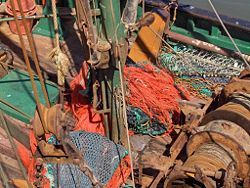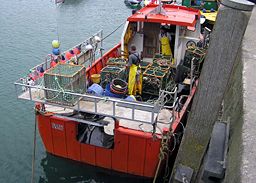Difference between revisions of "Fishery" - New World Encyclopedia
David Rogers (talk | contribs) |
m (Renaming Geography Category) |
||
| Line 1: | Line 1: | ||
| − | [[Category: | + | [[Category:Nations and places]] |
[[image:fishery.lobsterboat.arp.750pix.jpg|thumb|right|256px|A [[lobster]] boat unloading its catch in [[Ilfracombe]] harbour, [[North Devon]], [[England]] ]] | [[image:fishery.lobsterboat.arp.750pix.jpg|thumb|right|256px|A [[lobster]] boat unloading its catch in [[Ilfracombe]] harbour, [[North Devon]], [[England]] ]] | ||
Revision as of 13:58, 24 April 2006
Fisheries is the generic name given to the activity of catching marine or freshwater fish to provide humans with food, recreation and economically valuable, marketable products. The practice of fishing can be as simple as one person with a pole or net catching fish for personal enjoyment (sport fisheries) or for food for himself and family to the highly advanced commerical fishing technology where hundreds of tons of fish are caught daily. The activity of fishing has its core in the ancient "hunting and gathering" practices that predate agriculture by thousands of years. However beyond economic harvesting, the catching of fish has been perhaps the most universal recreational pastime of man. The ability to "catch" something that is wild and natural holds a particular fascination that is pan cultural and international. The overall scope of fisheries is global with whole efforts of coastal nations focusing on the catch of local fish and "distant water" fishing thousands of miles beyond their own shorelines. In addtion to providing human food and [[sport/recreational fishing), other products derived from fishing include [ or fish products such as fish oil. Industrial fisherieswhere the catch is not intended for direct human consumption and [aquarium|ornamental fish]].
Regardless of purpose, however, the term fishery generally refers to a fishing effort centered on either a particular ecoregion or a particular species or type of fish or aquatic animal, and usually fisheries are differentiated by both criteria. Examples would be the salmon fishery of Alaska, the cod fishery off the Lofoten islands or the tuna fishery of the Eastern Pacific. Most fisheries are marine, rather than freshwater; most marine fisheries are based near the coast. This is not only because harvesting from relatively shallow waters is easier than in the open ocean, but also because fish are much more abundant near the coastal shelf, due to coastal upwelling and the abundance of nutrients available there.

Fisheries historically

Fisheries have been important parts of human life and food production throughout history. Fisheries have become a part of human cultures and mythologies, providing a community identity and a subject for artists throughout the ages. Partially, this is because fisheries are irretrievably wrapped up in humanity’s perpetual fascination with the sea, and partially, because they have been a major source of food and income for many communities throughout the ages.
One of the world’s longest-lasting trade histories is the trade of dry cod from the Lofoten area to the southern parts of Europe — Italy, Spain and Portugal. The trade in cod started during the Viking period or before, has been going on for more than 1,000 years and is still important.
In India, the Pandyas, a classical Dravidian Tamil kingdom, were known for the pearl fishery as early as the 1st century B.C.E. Their seaport Tuticorin was known for deep sea pearl fishing. The paravas, a Tamil caste centred in Tuticorin, developed a rich community because of their pearl trade, navigation knowledge and fisheries.
Fisheries in the present day
Today, fisheries are estimated to provide 16% of the world population's protein, and that figure is considerably elevated in some developing nations and in regions that depend heavily on the sea. Fisheries are a huge global business and provide income for millions of people. Fisheries have been and continue to be culturally important for many communities as well.
According to the Food and Agriculture Organization of the United Nations, total world capture fisheries production in 2000 was 86 million tons (FAO 2002). The top producing countries were, in order, the China (excluding Hong Kong and Taiwan), Peru, Japan, the United States, Chile, Indonesia, Russia, India, Thailand, Norway, and Iceland. Those countries accounted for more than half of the world's production; China alone accounted for a third of the world's production. Of that production, over 90% was marine and less than 10% was inland.
There are large and important fisheries worldwide for various species of fish, mollusks and crustaceans. However, a very small number of species support the majority of the world’s fisheries. Some of these species are herring, cod, anchovy, tuna, flounder, mullet, squid, shrimp, salmon, crab, lobster, oyster and scallops. All except these last four provided a worldwide catch of well over a million tonnes in 1999, with herring and sardines together providing a catch of over 22 million metric tons in 1999. Many other species as well are fished in smaller numbers, both locally and globally.
Methods
Fishing methods vary according to the region, the species being fished for, and the amount of income and technology available to the fisher. A fishery can consist of one man with a small boat hand-casting nets, to a huge fleet of trawlers processing tons of fish per day. Some common commercial techniques today are trawling, seining, driftnetting, handlining, longlining, gillnetting, and diving.
Fisheries and communities
For some communities, both currently and historically, fisheries provide not only a source of food and work but also a community and cultural identity.
This shows up in art, literature, and traditions. These communities are generally those that have been historically dependent on fishing as a source of income and food.
Fisheries science
Fisheries science is the academic discipline of managing and understanding fisheries. It draws on the disciplines of biology, ecology, oceanography, economics and management to attempt to provide an integrated picture of fisheries. It is typically taught in a university setting, and can be the focus of an undergraduate, master's or Ph.D. program. It is in universities worldwide, usually organised as multidisciplinary programs involving parts of traditional university disciplines. In some cases new disciplines have emerged, as in the case of bioeconomics. A few universities also offer fully integrated programs in fisheries science.
Important issues and topics in fisheries
Considering the importance of fisheries, and that they depend on a natural resource, it is no surprise that there are many pressing environmental issues surrounding them. These can be classed into issues that involve the availability of fish to be caught, such as overfishing, sustainable fisheries, and fisheries management; and issues surrounding the impact of fishing on the environment, such by-catch. These fishery conservation issues are generally considered part of marine conservation, and many of these issues are addressed in fisheries science programs. They are also, however, controversial. There is an apparent and growing disparity between the availability of fish to be caught and humanity’s desire to catch them, a problem that is exacerbated by the rapidly growing world population. As with some other environmental issues, often the people engaged in the activity of fishing – the fishers – and the scientists who study fisheries science, who are often acting as fishery managers, are in conflict with each other, as the dictates of economics mean that fishers have to keep fishing for their livelihood, but the dictates of sustainable science mean that some fisheries must close or reduce to protect the health of the population of the fish themselves. It is starting to be realized, however, that these two camps must work together to ensure fishery health through the 21st century and beyond.
For further information
The literature on fisheries—both scientific and popular—is vast. The literature is subdivided into dozens of topics, from fishing gear design, to the impact of fish biology and oceanography on fisheries, to how to most effectively manage fisheries. Some good places to start are the websites of fisheries science departments and the catalogs of university libraries. Some well known journals about fisheries are Fisheries, Fisheries Oceanography, Fishery Bulletin, and The Canadian Journal of Aquatic and Fishery Sciences. In addition, many countries have their own regional journals.
ReferencesISBN links support NWE through referral fees
- Castro, P. and M. Huber. (2003). Marine Biology. 4th ed. Boston: McGraw Hill.
- FAO Fisheries Department. (2002). The State of World Fisheries and Aquaculture. Rome: Food and Agriculture Organization of the United Nations.
- International Collective in Support of Fishworkers website
Other Wikipedia articles
- Agriculture
- Aquaculture
- Conservation
- Ecosystem
- Fish
- Fish farming
- Hatcheries
- Marine conservation
- Marine ecosystem
- Oceanography
- World Ocean Day
- Department of Fisheries and Oceans Canada
- International_Council_for_the_Exploration_of_the_Sea
- Project AWARE
External links ((Use if needed but discard later))
- FAO Fisheries Department and its SOFIA report
- State of World Fisheries – A summary for non-specialists of the above FAO report by GreenFacts.
- The International Council for the Exploration of the Sea (ICES)
- NOAA Fisheries (National Marine Fisheries Service, United States)
- The American Fisheries Society
- The National Fisheries Institute – The Fish and Seafood Trade Association
- The International Institute of Fisheries Economics and Trade (IIFET)
- Fisheries and Oceans Canada
- German Educator in Fisheries, Specialist in Fancy Goldfish and Fishhealth, with Forum and large Picture-Gallery
Credits
New World Encyclopedia writers and editors rewrote and completed the Wikipedia article in accordance with New World Encyclopedia standards. This article abides by terms of the Creative Commons CC-by-sa 3.0 License (CC-by-sa), which may be used and disseminated with proper attribution. Credit is due under the terms of this license that can reference both the New World Encyclopedia contributors and the selfless volunteer contributors of the Wikimedia Foundation. To cite this article click here for a list of acceptable citing formats.The history of earlier contributions by wikipedians is accessible to researchers here:
The history of this article since it was imported to New World Encyclopedia:
Note: Some restrictions may apply to use of individual images which are separately licensed.
